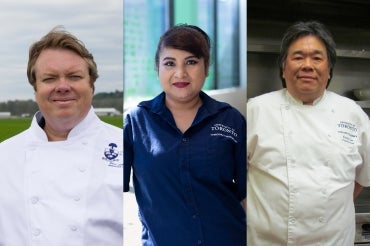
From left to right: Chef Jaco Lokker, Danita Seenarine, Chef Edward Low
Published: August 17, 2020
By Jenny Rodrigues
There’s no recipe to follow when providing food to students on campus during a pandemic. Staff at the University of Toronto’s Food Services had to add a heavy dose of agility to processes and policies overnight to ensure students who relied on them were staying fed.
“There was a lot of uncertainty about what the future held,” says Jaco Lokker, director of culinary operations and executive chef.
Looking back on the early days of the pandemic, Lokker recalls that while many staff were concerned for the safety of health of their own families, they were also deeply aware of “their commitment to the students who remained on campus and the importance of making sure they were looked after as well.”
Lokker’s team oversees the dining programs at three residences at St. George – Chestnut, New College and Campus One – as well as campus catering and some retail locations. During the academic year, the team numbers at around 230 staff members. Currently, around 22 staff members are actively working to serve on average 212 meals a day. (Read stories about other U of T residences here and our plans for a safe return to campus here.)
For many of those students, the Food Services staff were some of the few familiar faces they were able to interact with on a daily basis while isolating in their residences.
Danita Seenarine, a Food Services staff member who has worked at Chestnut Residence & Conference Centre for more than 20 years, says it was important to be a comforting presence to the diners. As a frontline staff member, she’s the friendly face that many students interact with when picking up their meals.
“Some students who weren’t able to go back home are feeling homesick, so we are making sure they feel happy to see us and know that we are here to support them,” she says. “I treat them as if they were my own children. We treat them like our family. I’ve continued to keep up conversations with them to encourage them.”
While showing their care and kindness during those in-person interactions, the staff also devised a safe way for students to order and receive their snacks and meals.
The menu was pared down to offer a hot or cold option in a to-go box, so that diners could pick up their meals and return to their rooms. An online menu was also created so that students could check out their meal options in advance and pick up a box, snack and drink with minimal contact.
Lokker says it was important to make the meals something students would look forward to, from the food itself, to the opportunity for connection.
“When you’re quarantined, you can’t go anywhere and meals and food become all that’s left in a sense,” he says. “We focused on bringing that extra bit of joy to our students through the dining experience, because it was probably one of the very few times that they got to interact with people in a day.”
One way the team sought to bring joy to the students was ensuring that the menu remained innovative – such as a fun breakfast ramen – that kept diners looking forward to their meals.
“The diners have been happy with the transition to the boxed meal program, because they felt that we were taking their safety seriously,” says Chef Edward Low, executive chef at Chestnut.
“Some even commented that they thought the food tasted better than before,” says Lokker. “The quality of the food didn’t change, but the students have just been getting more joy out their meals.”
In the early days of the quarantine, there were still more than 200 students living in the three residences. The staff created about 600 boxed meals a day to feed them. To accommodate that volume, the ballroom at Chestnut was converted into an assembly area, ensuring staff were working at a safe physical distance from each other while packaging the food to be shipped across campus.
Colin Porter, executive director of Food Services, says the commitment of the staff to support the students and a teamwork mindset was key to helping the office make a successful pivot once public health officials enacted strict policies at the onset of the pandemic.
“The Food Services team have truly come together and used their expertise to ensure our students didn’t experience any disruption of service and were still able to enjoy freshly prepared meals despite the limitations of the pandemic,” says Porter. “It’s been inspiring to witness how they’ve all remained so positive throughout it all.”
“I want to commend the entire Food Services team for stepping up in this time of uncertainty,” says Anne MacDonald, U of T’s assistant vice-president of ancillary services. “They should feel proud of the essential service they provided to our students.”
As the team looks ahead to the fall semester, they’ve used their experiences of the past four months to prepare for the large volume of students they will be feeding. The team has been stocking up on the takeaway boxes, cutlery kits and PPE for staff.
“The entire pandemic so far has been a big learning curve for all of us,” says Low. “We’re looking forward to meeting new students and offering them the same level of safety and service in September.”
